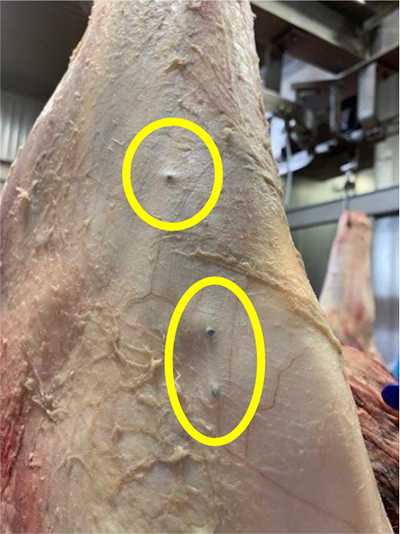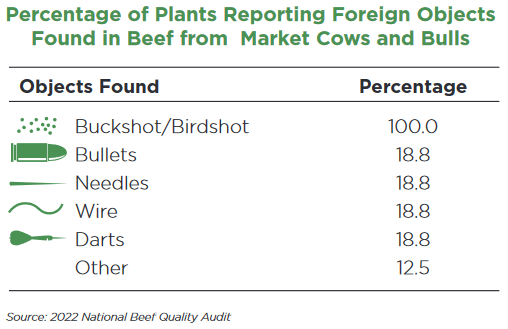Mark Z. Johnson, Oklahoma State University Extension Beef Cattle Breeding Specialist

Birdshot Embedded in Subcutaneous Fat Layer. Credit: Michaela Clowser, NCBA From the publication: A Black Spot in the Cattle Industry that’s Impossible to Chew
Birdshot or shotgun shell pellets have been found and reported in the beef supply since the first National Beef Quality Audit in the early 1990s and the incidence of this foreign material in the beef we produce is not subsiding. In fact, the opposite may be true.
According to the 2022 National Beef Quality Audit, birdshot is still a problem, with 100% of packing plants reporting shotgun pellets in beef from market cows and bulls. There are roughly 28 categories of items that are documented each year as foreign material in beef carcasses. Most of those items are found once to 15 times each on an annual basis and consist of large and easily identifiable objects. Birdshot, however, is found around 105 times a year and well over two times the rate of any other foreign object.
For context, if a ground beef processor makes 5 million ground beef patties each day, a defect rate of 1% would lead to 50,000 patties of wasted beef. A defect rate of 0.1% is 5,000 patties. A single incidence of birdshot found in the processing lines cost $10,000 in lost product and downtime. Why so much? If a pellet made it through the grinder, one pellet may have been sheared into numerous pieces that are barely detectable.
–
Bottom Line
Hunters are not causing this problem. There are some producers out there handling their cattle with shotguns. This is not only poor animal handling, but also inhumane. Birdshot will not bounce off cattle and somehow go away. No matter how stupid or waspy cows and bulls might act, they should never be shot at whether intentionally or by accident.
We need everyone on board to get the message out in producer meetings, educational programming, and word of mouth. If we focus on promoting the Right Way mentality of Beef Quality Assurance, we can make a difference. Ultimately, birdshot, needles, darts, and other foreign objects in beef are a food safety issue. Any abuse of animals is not acceptable and shotguns are not a cattle handling tool. This needs to stop!
–
References:
A Black Spot in the Cattle Industry that’s Impossible to Chew. Jason Duggin, UGA Beef Extension Specialist. Michaela Clowser, NCBA’s Director of Producer Education. Dr. Patty Scharko, Clemson Extension Veterinarian.
Right Way. Right Time. A Guide to Cull Cattle Management. National Cattlemen’s Beef Association
- Where Did That Weed Come From? The Importance of Weed Management Practices and Timings - December 5, 2025
- Sustainable U.S. Peanuts Kicks Off 2025 Crop Enrollment - December 5, 2025
- Grant Opportunity Available to Attend American Forage & Grassland Council Conference, Ashville – January 12-15 - December 5, 2025

